As a result of testing a mobile electronic document management platform based on E1, Apple OS is recognized as the fastest
Our company has completed comprehensive testing of compatibility of the E1 Euphrates robotic business process automation system with all major mobile platforms - iOS, MS Windows Phone, Android and Symbian!
As part of the testing, whose goals, of course, were to verify the convenience and effectiveness of the remote work of the mobile client on various “smart” phones,
4 types of smartphones from various manufacturers were chosen as “experimental”. Among them were iPhone 4S (iOS), HTC Titan X310E (MS Windows Phone), Nokia N8 (Symbian) and Samsung GALAXY S II (Android).
A fairly small screen of smartphones greatly complicates the process of working in remote mode. Thus, we created the most difficult conditions for testing the functionality of our mobile client.
All devices underwent comprehensive comprehensive testing of the E1 Euphrates mobile client with access to all the necessary commands and work functions. During testing, all the fields of the registration control card (RSC) of the documents on which the testing is carried out were filled.
A little description of the testing.
Launching the “Euphrates-TKM” on the device is carried out by a single click of the remarkable red E1 icon on the desktop of the mobile device (Fig. 1).
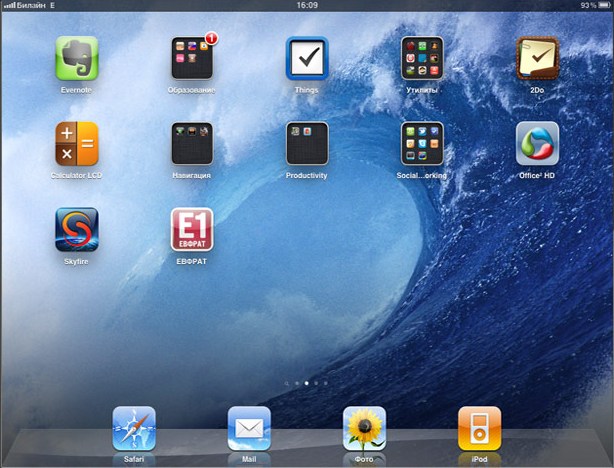
Fig. 1. Gadget desktop
Before starting any work in the system, it is necessary to configure a wireless Internet access network on a mobile device. Smartphones were in exactly the same conditions: Wifi: 802.11n; 150 Mbps, on all devices stable communication with the E1 Euphrates server and high speed of task execution were provided.
After all the necessary settings and manipulations, we get to the "Login". Logging in is strictly by login and password and only for users registered in the E1 Euphrates (Fig. 2).

Fig. 2. Invitation window for Euphrates-TKM work
Finally, we can use personal data!
The employees who conducted the tests had a whole scenario in which it was supposed to start 16 main business processes, including 52 tasks.
We will dwell on some of the tested problems in more detail.
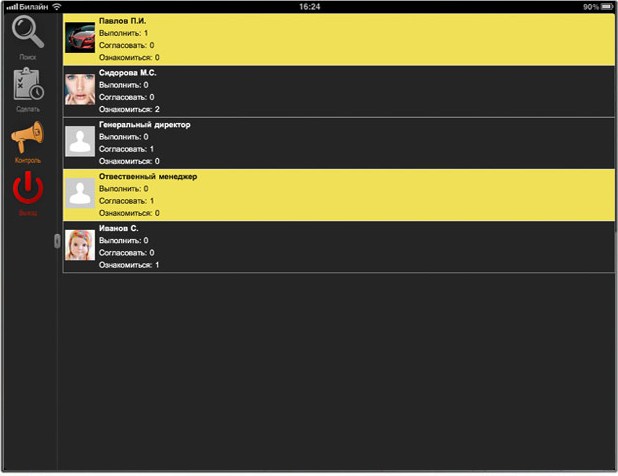
Fig. 3. The list of tasks assigned to you, grouped by the authors of the tasks with the highest priority of the tasks.
The list (Fig. 3) indicates the author of the task, color indicates the highest priority of the task from the entire list of tasks from this user. The numbers indicate the number of tasks “complete” - assignments, “coordinate” - approvals, “familiarize” - acquaintances. When you select a list item, details are given for tasks (assignments, approvals, etc.) from this user.
In testing, we measured the time taken to create these same tasks. In the table

you can see how much time each task "took", or rather its creation, on each of the experimental devices.
Suppose we have selected an order for details. When clicked, the window of Fig. 4 opens.
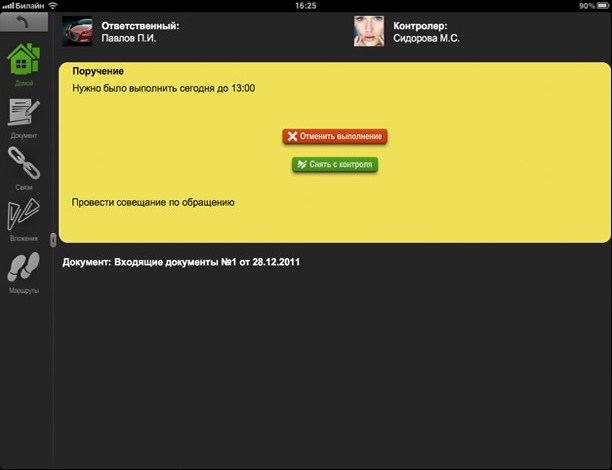
Fig. 4. Viewing the details of a task assigned (task) with the possibilities for its execution. A
task of the task type can be executed in 2 ways: “cancel execution” or “remove from control” by selecting the corresponding button. When choosing any button, the user will be prompted to enter a comment in the comment window (see. Fig. 5).

Fig. 5. Entering a comment
The entered comment is reflected during the execution of the task (can be viewed through the routes window). After entering a comment, you must click the OK button to complete the task; if you click Cancel, the task will not be executed. You can enter an empty comment in the field.
Matching

Fig. 6. View the details of the task assigned (coordination) with the possibilities for its implementation.
The actions, as you might guess, are very similar to a “commission”. And the differences are clearly demonstrated in Fig. 6.
Viewing a document associated with a task
In E1, you can view a document associated with a given task of a user without the ability to edit a document, which is very important in almost any organization.
When viewing a document, there are the following options:
1. Viewing the document's document (simplified form, limited set of fields) - see fig. 7. To view, select the "document" button of the button bar. The composition of the fields of the Republic of Kazakhstan is also clearly shown in Fig. 7.
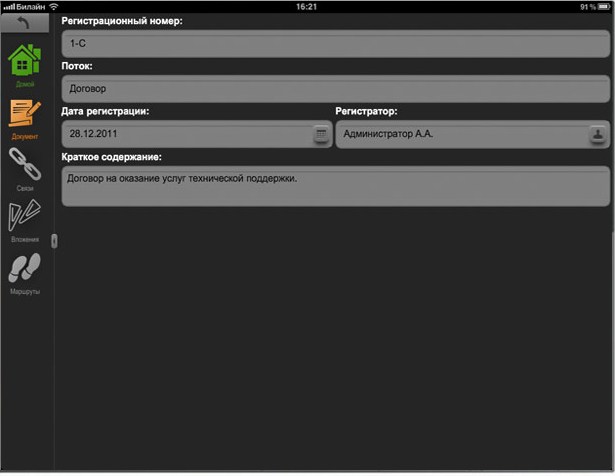
Fig. 7. Fields of the simplified document RK
This screen is available only for viewing the details of the document without the possibility of editing them.
2. View the list of documents associated with this document (Fig. 8). To view the list of documents, you must select the "link" button of the button bar. A list of related documents is displayed in a table.
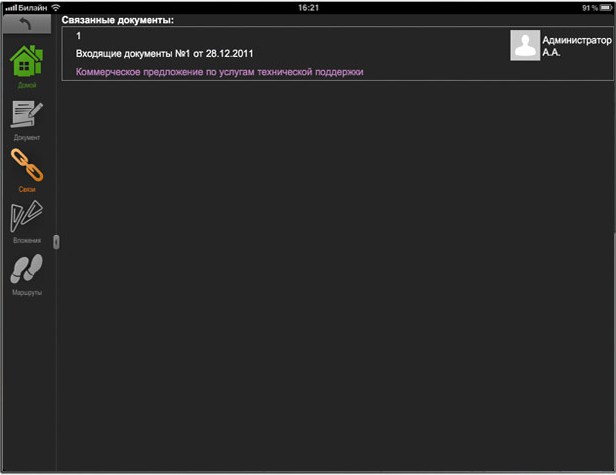
Fig. 8. Related documents
3. View a list of attached files to the document. To view the list, select the "attachment" button. The list is displayed in the form of a tree, in which the file name is shown as the top of the tree, when opened, a list of versions of the attached document is shown (Fig. 9).
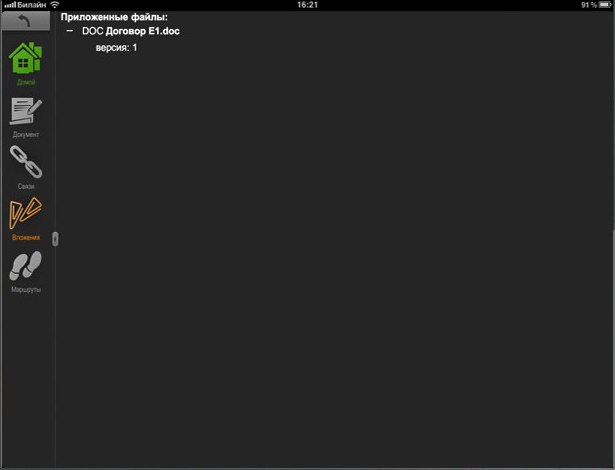
Fig. 9. The tree of attached files and their versions
The attached file is viewed by selecting the vertex (line) of the document version, after which the attached file is displayed (for now only in graphic format
4. Viewing the attached document. Viewing is carried out by selecting the document version in the tree of attached documents and their versions (see Fig. 10 ).
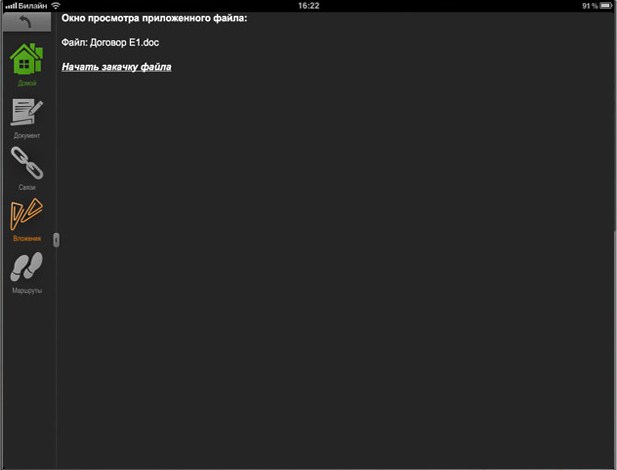
Fig.10. window view the attached document
5. Check the routes associated with the document. to view the list, select the 'route' (see. Fig. 11).
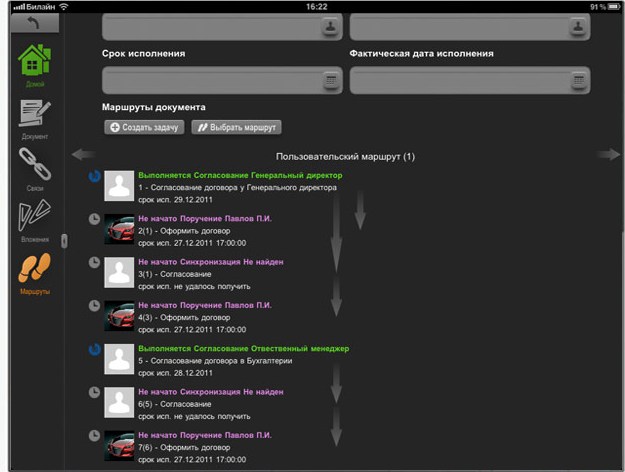
Figure 11. difficult hike
to view a complex route tester optionally It was widely regarded as one to spend time:

After all of the tests, with a sense of accomplishment, leaving the system.
In Fig. 12, you can see the image of the button that exits the Euphrates-TKM and terminates the session with the system of this user.

Fig. 12. Exit.
At the end of the “physical” testing, a comparative analysis of the mobile client was conducted. The most obvious example for comparing functionality, in our opinion, is the creation of a comparison table. Following its results, the following schedule was collected:
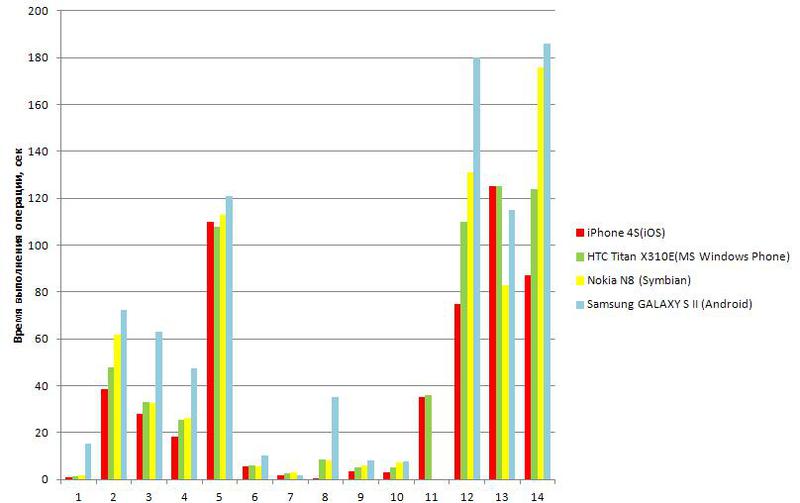
1 - login to the system; 2 - execution of an order, according to which the user is an executor; 3 - implementation of the incoming approval; 4 - performing familiarization with the document; 5 - implementation of control functions over tasks in which the user is the controller; 6 - search and view available documents based on the search for details; 7 - search and viewing of tasks available to you based on a search by task details; 8 - view available document routes; 9 - view of the main fields of the ALAC of available documents; 10 - view documents associated with this document; 11 - transition and viewing of related documents, their details, available routes, attached files, etc .; 12 - view a list of attached files and the attached files themselves and their versions in graphical format; 13 - viewing the list of attached files and the attached files themselves and their versions in doc format; 14 - view the list of attached files and the attached files themselves and their versions in xls-format.
Based on a consolidated assessment of the test data, the best E1 Euphrates results were shown on the iPhone 4S (iOS) smartphone, where the best execution time for all business processes was recorded.
Silver received a smartphone HTC Titan X310E (MS Windows Phone), which recorded the second fastest time for executing business processes, but, despite the second place, the best time in the implementation of 13 separate tasks.
In the next position, Nokia N8 (Symbian) is the best time to complete 6 separate tasks.
When testing the Samsung GALAXY S II (Android), there were certain performance problems. In particular, in some cases, the application file was not opened quickly enough, and a relatively long response time was observed when searching the registrar and the contents of the document. According to specialists from the Cognitive Technologies development department, this fact can be explained by the insufficiently powerful wireless adapter of this device. In general, in everyday work, users are unlikely to feel any inconvenience associated with the speed of the system on the Android platform. At the same time, when performing 9 tasks on this smartphone, the highest speed among all devices was demonstrated.
As mentioned earlier, the iPhone 4S became the favorite in the “race” of smartphones, or rather the work of the mobile client on them. It was he who scored the maximum score for usability and usability.
Mikhail Potapenko, Head of Cognitive Technologies Electronic Document
 Management, “Mobility is an integral feature of modern business, so the ability to provide remote work becomes an essential part of the functionality of modern business process management systems. Today “E1 Euphrates” is one of the few systems that provides reliable operation with all major types of mobile devices, which greatly expands its capabilities as a tool for remote work with documents and business processes. ”
Management, “Mobility is an integral feature of modern business, so the ability to provide remote work becomes an essential part of the functionality of modern business process management systems. Today “E1 Euphrates” is one of the few systems that provides reliable operation with all major types of mobile devices, which greatly expands its capabilities as a tool for remote work with documents and business processes. ”
As part of the testing, whose goals, of course, were to verify the convenience and effectiveness of the remote work of the mobile client on various “smart” phones,
4 types of smartphones from various manufacturers were chosen as “experimental”. Among them were iPhone 4S (iOS), HTC Titan X310E (MS Windows Phone), Nokia N8 (Symbian) and Samsung GALAXY S II (Android).
A fairly small screen of smartphones greatly complicates the process of working in remote mode. Thus, we created the most difficult conditions for testing the functionality of our mobile client.
All devices underwent comprehensive comprehensive testing of the E1 Euphrates mobile client with access to all the necessary commands and work functions. During testing, all the fields of the registration control card (RSC) of the documents on which the testing is carried out were filled.
A little description of the testing.
Launching the “Euphrates-TKM” on the device is carried out by a single click of the remarkable red E1 icon on the desktop of the mobile device (Fig. 1).

Fig. 1. Gadget desktop
Before starting any work in the system, it is necessary to configure a wireless Internet access network on a mobile device. Smartphones were in exactly the same conditions: Wifi: 802.11n; 150 Mbps, on all devices stable communication with the E1 Euphrates server and high speed of task execution were provided.
After all the necessary settings and manipulations, we get to the "Login". Logging in is strictly by login and password and only for users registered in the E1 Euphrates (Fig. 2).

Fig. 2. Invitation window for Euphrates-TKM work
Finally, we can use personal data!
The employees who conducted the tests had a whole scenario in which it was supposed to start 16 main business processes, including 52 tasks.
We will dwell on some of the tested problems in more detail.

Fig. 3. The list of tasks assigned to you, grouped by the authors of the tasks with the highest priority of the tasks.
The list (Fig. 3) indicates the author of the task, color indicates the highest priority of the task from the entire list of tasks from this user. The numbers indicate the number of tasks “complete” - assignments, “coordinate” - approvals, “familiarize” - acquaintances. When you select a list item, details are given for tasks (assignments, approvals, etc.) from this user.
In testing, we measured the time taken to create these same tasks. In the table

you can see how much time each task "took", or rather its creation, on each of the experimental devices.
Suppose we have selected an order for details. When clicked, the window of Fig. 4 opens.

Fig. 4. Viewing the details of a task assigned (task) with the possibilities for its execution. A
task of the task type can be executed in 2 ways: “cancel execution” or “remove from control” by selecting the corresponding button. When choosing any button, the user will be prompted to enter a comment in the comment window (see. Fig. 5).

Fig. 5. Entering a comment
The entered comment is reflected during the execution of the task (can be viewed through the routes window). After entering a comment, you must click the OK button to complete the task; if you click Cancel, the task will not be executed. You can enter an empty comment in the field.
Matching

Fig. 6. View the details of the task assigned (coordination) with the possibilities for its implementation.
The actions, as you might guess, are very similar to a “commission”. And the differences are clearly demonstrated in Fig. 6.
Viewing a document associated with a task
In E1, you can view a document associated with a given task of a user without the ability to edit a document, which is very important in almost any organization.
When viewing a document, there are the following options:
1. Viewing the document's document (simplified form, limited set of fields) - see fig. 7. To view, select the "document" button of the button bar. The composition of the fields of the Republic of Kazakhstan is also clearly shown in Fig. 7.

Fig. 7. Fields of the simplified document RK
This screen is available only for viewing the details of the document without the possibility of editing them.
2. View the list of documents associated with this document (Fig. 8). To view the list of documents, you must select the "link" button of the button bar. A list of related documents is displayed in a table.

Fig. 8. Related documents
3. View a list of attached files to the document. To view the list, select the "attachment" button. The list is displayed in the form of a tree, in which the file name is shown as the top of the tree, when opened, a list of versions of the attached document is shown (Fig. 9).

Fig. 9. The tree of attached files and their versions
The attached file is viewed by selecting the vertex (line) of the document version, after which the attached file is displayed (for now only in graphic format
4. Viewing the attached document. Viewing is carried out by selecting the document version in the tree of attached documents and their versions (see Fig. 10 ).

Fig.10. window view the attached document
5. Check the routes associated with the document. to view the list, select the 'route' (see. Fig. 11).

Figure 11. difficult hike
to view a complex route tester optionally It was widely regarded as one to spend time:

After all of the tests, with a sense of accomplishment, leaving the system.
In Fig. 12, you can see the image of the button that exits the Euphrates-TKM and terminates the session with the system of this user.

Fig. 12. Exit.
At the end of the “physical” testing, a comparative analysis of the mobile client was conducted. The most obvious example for comparing functionality, in our opinion, is the creation of a comparison table. Following its results, the following schedule was collected:

1 - login to the system; 2 - execution of an order, according to which the user is an executor; 3 - implementation of the incoming approval; 4 - performing familiarization with the document; 5 - implementation of control functions over tasks in which the user is the controller; 6 - search and view available documents based on the search for details; 7 - search and viewing of tasks available to you based on a search by task details; 8 - view available document routes; 9 - view of the main fields of the ALAC of available documents; 10 - view documents associated with this document; 11 - transition and viewing of related documents, their details, available routes, attached files, etc .; 12 - view a list of attached files and the attached files themselves and their versions in graphical format; 13 - viewing the list of attached files and the attached files themselves and their versions in doc format; 14 - view the list of attached files and the attached files themselves and their versions in xls-format.
Based on a consolidated assessment of the test data, the best E1 Euphrates results were shown on the iPhone 4S (iOS) smartphone, where the best execution time for all business processes was recorded.
Silver received a smartphone HTC Titan X310E (MS Windows Phone), which recorded the second fastest time for executing business processes, but, despite the second place, the best time in the implementation of 13 separate tasks.
In the next position, Nokia N8 (Symbian) is the best time to complete 6 separate tasks.
When testing the Samsung GALAXY S II (Android), there were certain performance problems. In particular, in some cases, the application file was not opened quickly enough, and a relatively long response time was observed when searching the registrar and the contents of the document. According to specialists from the Cognitive Technologies development department, this fact can be explained by the insufficiently powerful wireless adapter of this device. In general, in everyday work, users are unlikely to feel any inconvenience associated with the speed of the system on the Android platform. At the same time, when performing 9 tasks on this smartphone, the highest speed among all devices was demonstrated.
As mentioned earlier, the iPhone 4S became the favorite in the “race” of smartphones, or rather the work of the mobile client on them. It was he who scored the maximum score for usability and usability.
Mikhail Potapenko, Head of Cognitive Technologies Electronic Document
 Management, “Mobility is an integral feature of modern business, so the ability to provide remote work becomes an essential part of the functionality of modern business process management systems. Today “E1 Euphrates” is one of the few systems that provides reliable operation with all major types of mobile devices, which greatly expands its capabilities as a tool for remote work with documents and business processes. ”
Management, “Mobility is an integral feature of modern business, so the ability to provide remote work becomes an essential part of the functionality of modern business process management systems. Today “E1 Euphrates” is one of the few systems that provides reliable operation with all major types of mobile devices, which greatly expands its capabilities as a tool for remote work with documents and business processes. ”